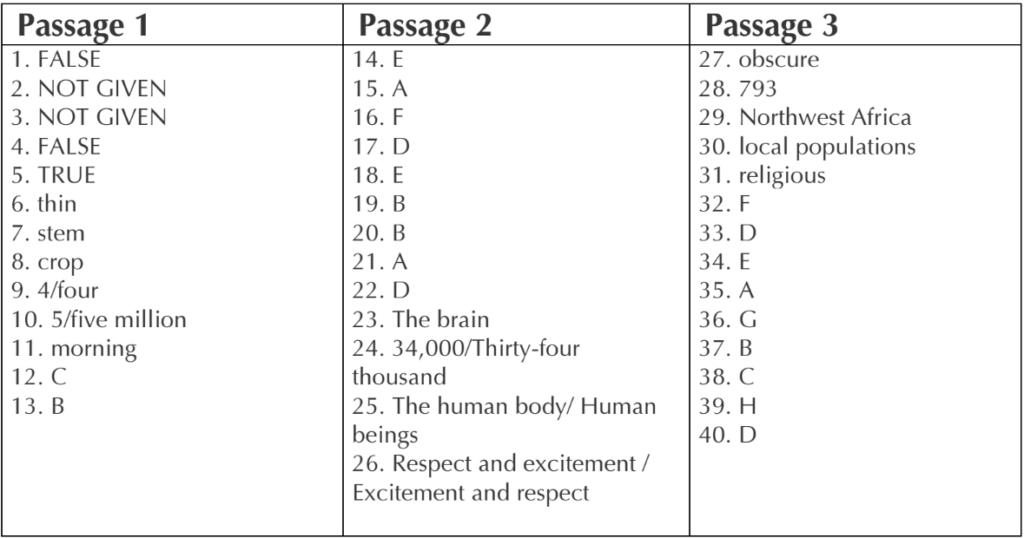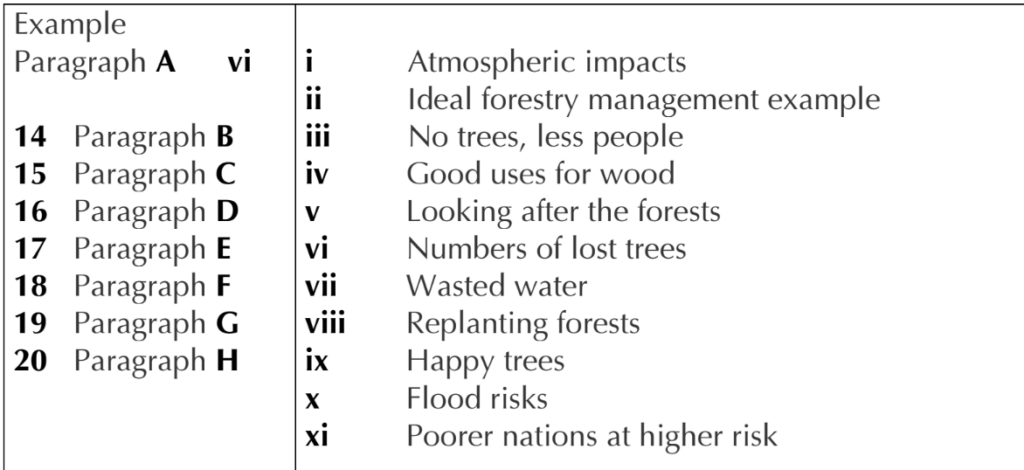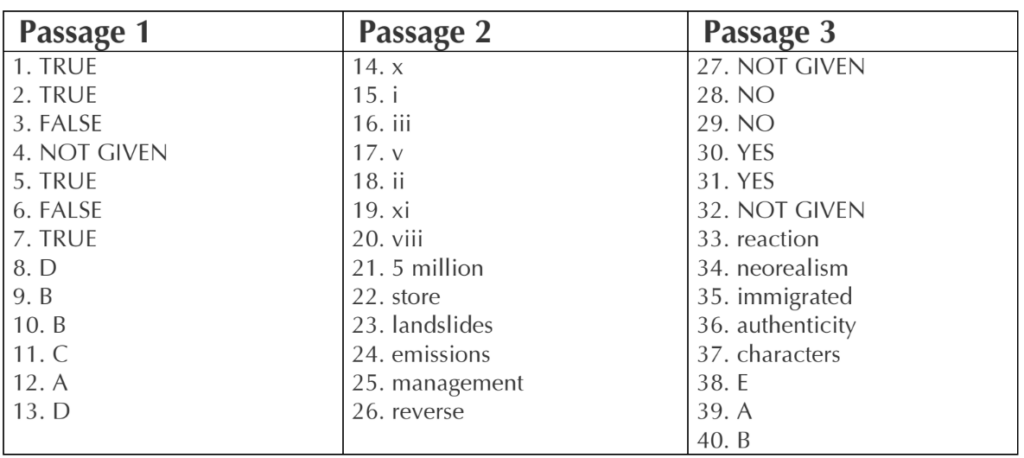- Passage 1: Video Practice Test!
- Passage 2: Video Practice Test!
- Passage 3: Video Practice Test!
1 – THE PLIGHT OF RICE
A.
Rice is a tall grass with a drooping panicle that contains numerous edible grains and has been cultivated in China for more than 6,000 years. A staple throughout Asia and large parts of Africa, it is now grown in flooded paddy fields from sea level to high mountains and harvested three times a year. According to the Food and Health Organisation of the United Nations, around four billion people currently receive a fifth of their calories from rice.
B.
Recently, Japan, South Korea, and Taiwan have slightly reduced rice consumption due to the adoption of more western diets, but almost all other countries have raised their consumption due to population increase. Yet, since 1984, there have been diminishing rice yields around the world.
C.
From the 1950s to the early 1960s, rice production was also suffering: India was on the brink of famine, and China was already experiencing one. In the late 1950s, Norman Borlaug, an American plant pathologist, began advising Punjab State in northwestern India to grow a new semi- dwarf variety of wheat. This was so successful that, in 1962, a semi- dwarf variety of rice, called IR8, developed by the Philippine ·International Rice Research Institute (IRRI), was planted throughout Southeast Asia and India. This semi-dwarf variety heralded the Green Revolution, which saved the lives of millions of people by almost doubling rice yields: from 1.9 metric tons per hectare in 1950-64, to 3.5 metric tons in 1985-98.
D.
IR8 survived because, as a semi-dwarf, it only grows to a moderate height, and it does not thin out, keel over, and drown like traditional varieties. Furthermore, its short thick stem is able to absorb chemical fertilisers, but, as stem growth is limited, the plant expends energy on producing a large panicle of heavy seeds, ensuring a greater crop.
E.
However, even with a massive increase in rice production, semi-dwarf varieties managed to keep up with population growth for only ten years. In Africa, where rice consumption is rising by 20% annually, and where one-third of the population now depends on the cereal, this is disturbing. At the current rate, within the next 20 years, rice will surpass maize as the major source of calories on that continent. Meantime, even in ideal circumstances, paddies worldwide are not producing what they once did, for reasons largely unknown to science. An average 0.8% fall in yields has been noted in rich rice-growing regions; in less ideal ones, flood, drought and salinity have meant yields have fallen drastically, sometimes up to 40%. F. The sequencing of the rice genome took place in 2005, after which the IRRI developed genetically modified flood-resistant varieties of rice, called Sub 1, which produce up to four times more edible grain than non-modified strains. In 2010, a handful of farmers worldwide were planting IRRI Sub 1 rice; now, over five million are doing so. Currently, drought- and salt-resistant varieties are being trialled since most rice is grown in the great river basins of the Brahmaputra, the Irrawaddy, and the Mekong that are all drying up or becoming far saltier.
G.
With global warming, many rice-growing regions are hotter than 20 years ago. Nearly all varieties of rice; including IR8, flower in the afternoon, but the anthers – little sacs that contain male pollen – wither and die in soaring temperatures. IRRI scientists have identified one variety of rice, known as Odisha, that flowers in the early morning and they are in the process of genetically modifying IR8 so it contains Odisha-flowering genes, although it may be some time before this is released.
H.
While there is a clear need for more rice, many states and countries seem less keen to influence agricultural policy directly than they were in the past. Some believe rice demand will dip in wealthier places, as occurred in Japan, South Korea, and Taiwan; others consider it more prudent to devote resources to tackling obesity or to limiting intensive farming that is environmentally destructive.
I.
Some experts say where there is state intervention it should take the form of reducing subsidies to rice farmers to stimulate production; others propose that small landholdings should be consolidated into more economically viable ones. There is no denying that land reform is pressing, but many governments shy away from it, faring losses at the ballot box, all the while knowing that rural populations are heading for the city in droves anyway. And, as they do so, cities expand, eating up fertile land for food production.
J.
One can only hope that the IRRI and other research institutions will spearhead half a dozen mini green revolutions, independently of uncommitted states.
Questions 1 – 5:
Which section A – I contains the following information?
1/ Rice is only grown at a low elevation.
2/ Rice has been cultivated in Africa for 3,000 years.
3/ Since 1984, rice yields have decreased due to infestations of pests.
4/ Norman Borlaug believed Punjabi farmers should grow semi-dwarf rice.
5/ The Green Revolution increased rice yields by around 100%.
Questions 6-1
Choose NO MORE THAN 1 WORD / NUMBER from the passage for each answer
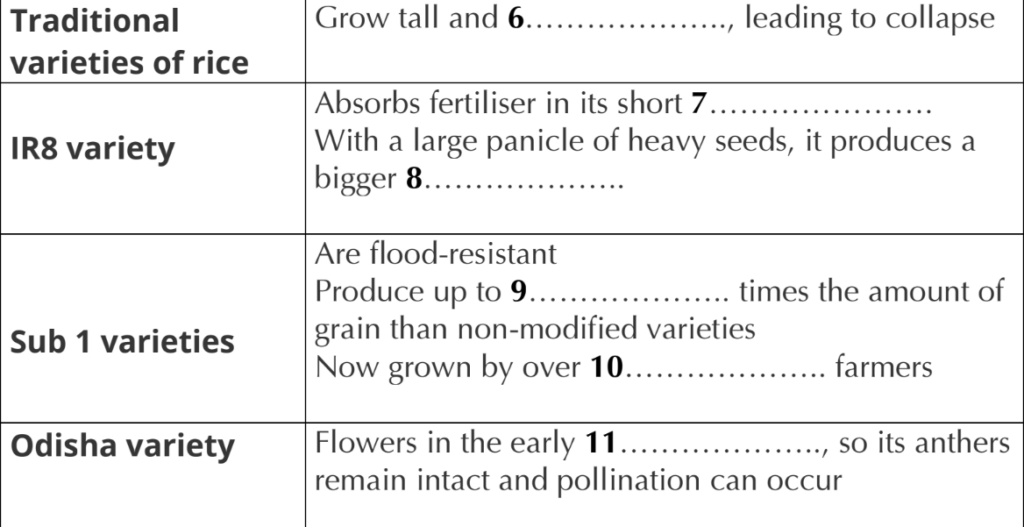
Questions 12 – 13:
12/ States are more interested in………than stimulating rice production.
A increasing wheat production
B reducing farm subsidies
C confronting obesity
D consolidating land holdings
13/ ……..disappearing as urbanisation speeds up.
A Intensive farming is
B Fertile land is
C Clean water is
D Agricultural institutes are
2- A New Perspective on Bacteria
A
Microbes are organisms too small to be seen by the naked eye, including bacteria, blue-green algae, yeasts, fungi, viruses, and viroids. A large, diverse group, almost all bacteria are between one and ten μ1 (larger ones reach 0.5 mm). Generally single-celled, with a distinctive cellular structure lacking a true nucleus, most bacterial genetic information is carried on a DNA loop in the cytoplasm2 with the membrane possessing some nuclear properties. There are three main kinds of bacteria – spherical, rod-like, and spiral – known by their Latin names of coccus, bacillus, and spirillum. Bacteria occur alone, in pairs, clusters, chains, or more complex configurations. Some live where oxygen is present; others, where it is absent. The relationship between bacteria and their hosts is symbiotic, benefitting both organisms, or the hosts may be destroyed by parasitic or disease-causing bacteria.
B
In general, humans view bacteria suspiciously, yet it is now thought they partly owe their existence to microbes living long, Jong ago. During photosynthesis, plants produce oxygen that humans need to fuel blood cells. Most geologists believe the early atmosphere on Earth contained very little oxygen until around 21⁄2 billion years ago when microbes bloomed. Ancestral forms of cyanobacteria, for example, evolved into chloroplasts – the cells that carry out photosynthesis. Once plants inhabited the oceans, oxygen levels rose dramatically, so complex life forms could eventually be sustained. The air humans breathe today is oxygen-rich, and the majority of airborne microbes are harmless, but the air does contain industrial pollutants, allergens, and infectious microbes or pathogens that cause illness
C
The fact is that scientists barely understand microbes. Bacteria have been proven to exist only in the past 350 years; viruses were discovered just over 100 years ago, but in the past three decades, the ubiquity of microbes has been established with bacteria found kilometres below the Earth’s crust and in the upper atmosphere. Surprisingly, they survive in dry deserts and the frozen reaches of Antarctica; they dwell in rain and snow clouds, as well as inside every living creature. Air samples taken in 2006 from two cities in Texas contained at least 1,800 distinct species of bacteria, making the air as rich as the soil. These species originated both in Texas and as far away as western China. It now seems that the number of microbe species far exceeds the number of stars.
D
Inside every human being, there are trillions of bacteria with their weight estimated at 1.36 kg in an average adult, or about as heavy as the brain. Although tiny, 90% of cells in a human are bacterial. With around eight million genes, these bacteria outnumber genes in human cells by 300 times. The large intestine contains the most bacteria – almost 34,000 species – but the crook of the elbow harbours over 2,000 species. Many bacteria are helpful: digesting food; aiding the immune system; creating moisturiser; and, manufacturing vitamins. Some have highly specialised functions, like Bacteroides thetaiotaomicron, which breaks down plant starch, so an infant can make the transition from mother’s milk to a more varied diet. Undeniably, some bacteria are life-threatening. One, known as golden staph, Staphylococcus aureus, plagues hospitals, where it infects instruments and devours human tissue until patients die from toxic shock. Worse, it is still resistant to antibiotics.
E
Antibiotics themselves are bacteria. In 1928, Alexander Fleming discovered that a mould in his laboratory produced a chemical he named penicillin. In 1951, William Bouw collected soil from the jungles of Borneo that eventually became vancomycin. Pharmaceutical companies still hunt for beneficial bacteria, but Michael Fischbach from the University of California believes that the human body itself is a ready supply.
F
Scientific ignorance about bacteria is largely due to an inability to cultivate many of them in a laboratory, but recent DNA sequencing has meant populations can be analysed by a computer program without having to grow them. Fischbach and his team have created and trained a computer program to identify gene clusters in microbial DNA sequences that might produce useful molecules. Having collected microbial DNA from 242 healthy human volunteers, the scientists sequenced the genomes of 2,340 different species of microbes, most of which were completely new discoveries. In searching the gene clusters, Fischbach et al fund 3,118 common ones that could be used in pharmaceuticals, for example, a gene cluster from the bacterium Lactobacillus gasseri, successfully reared in the lab, produced a molecule they named lactocillin. Later, they discovered the structure of this was very similar to an antibiotic, LFF571, undergoing clinical trials by a major pharmaceutical company. To date, lactocillin has killed harmful bacteria, so it may also be a reliable antibiotic.
G
Naturally, the path to patenting medicine is strewn with failures, but, since bacteria have been living inside humans for millions of years, they are probably safe to reintroduce in new combinations and in large amounts. Undoubtedly, the fight against pathogens, like golden staph, must continue, but as scientists learn more about microbes, respect and excitement for them grow, and their positive applications become ever more probable. 1A micron= 10-6 m 2Material inside a cell.
Questions 14 – 18:
Which section A-G contains the following information?
14/ examples of bacteria as a patented medicine
15/ a description of bacteria
16/ gene cluster detection and culture
17/ humans are teeming with bacteria
18/ Fischbach’s hypothesis
Questions 19 – 22:
19/ What do almost all bacteria share?
A Their simple configurations
B Their cellular organisation
C Their survival without oxygen
D Their parasitic nature
20/ From the suffix ‘-bacillus’, what shape would you expect the
bacterium Paenibacillus to be?
A spherical
B rod-like
C spiral
D amorphous
21/ Why were ancient bacteria invaluable to humans?
A They contributed to higher levels of oxygen.
B They reduced widespread industrial pollution.
C They protected humans from intestinal ailments.
D They provided scientists with antibiotics.
22/ How prevalent are microbes?
A Not at all
B Somewhat
C Very
D Extremely
Questions 23 – 26:
Choose NO MORE THAN 3 WORDS from the passage for each answer.
23/ Which organ does the total weight of bacteria in a human body equal?
24/ Roughly how many bacterial species live in a human’s large intestine?
25/ In Fischbach’s view, where might useful bacteria come from in the
future?
26/ What do some scientists now feel towards microbes?
3 – READING PASSAGE 3
A.
In the last century, Vikings have been perceived in numerous different ways – vilified as conquerors and romanticised as adventurers. How Vikings have been employed in nation-building is a topic of some interest.
B.
In English, Vikings are also known as Norse or Norsemen. Their language greatly influenced English, with the nouns, ‘Hell’, ‘husband’, ‘law’, and ‘window’, and the verbs, ‘blunder’, ‘snub’, ‘take’, and ‘want’, all coming from Old Norse. However, the origins of the word ‘Viking’, itself, are obscure: it may mean ‘a Scandinavian pirate’, or it may refer to ‘an inlet’, or a place called Vik, in modem-day Norway, from where the pirates came. These various names – Vikings, Norse, or Norsemen, and doubts about the very word ‘Viking’ suggest historical confusion.
C.
Loosely speaking, the Viking Age endured from the late eighth to the mid-eleventh centuries. Vikings sailed to England in AD 793 to storm coastal monasteries, and subsequently, large swathes of England fell under Viking rule – indeed several Viking kings sat on the English throne. It is generally agreed that the Battle of Hastings, in 1066, when the Norman French invaded, marks the end of the English Viking Age, but the Irish Viking age ended earlier, while Viking colonies in Iceland and Greenland did not dissolve until around AD 1500.
D.
How much territory Vikings controlled is also in dispute – Scandinavia and Western Europe certainly, but their reach east and south is uncertain. They plundered and settled down the Volga and Dnieper rivers, and traded with modem-day Istanbul, but the archaeological record has yet to verify that Vikings raided as far away as Northwest Africa, as some writers claim.
E.
The issue of control and extent is complex because many Vikings did not return to Scandinavia after raiding but assimilated into local populations, often becoming Christian. To some degree, the Viking Age is defined by religion. Initially, Vikings were polytheists, believing in many gods, but by the end of the age, they had permanently accepted a new monotheistic religious system – Christianity.
F.
This transition from so-called pagan plunderers to civilised Christians is significant and is the view promulgated throughout much of recent history. In the UK, in the 1970s for example, schoolchildren were taught that until the Vikings accepted Christianity they were nasty heathens who rampaged throughout Britain. By contrast, today’s children can visit museums where Vikings are celebrated as merchants, pastoralists, and artists with a unique worldview as well as conquerors.
G.
What are some other interpretations of Vikings? In the nineteenth century, historians in Denmark, Norway, and Sweden constructed their own Viking ages for nationalistic reasons. At that time, all three countries were in crisis. Denmark had been beaten in war and ceded territory to what is now Germany. Norway had become independent from Sweden in 1905 but was economically vulnerable, so Norwegians sought to create a separate identity for themselves in the past as well as the present. The Norwegian historian, Gustav Storm, was adamant it was his forebears and not the Swedes’ or Danes’ who had colonised Iceland, Greenland, and Vinland, in what is now Canada. Sweden, meanwhile, had relinquished Norway to the Norwegians and Finland to the Russians; thus, in the late nineteenth century, Sweden was keen to boost its image with rich archaeological finds to show the glory of its Viking past.
H.
In addition to augmenting nationalism, nineteenth-century thinkers were influenced by an Englishman, Herbert Spencer, who described peoples and cultures in evolutionary terms similar to those of Charles Darwin. Spencer coined the phrase ‘survival of the fittest’, which includes the notion that, over time, there is not only technological but also moral progress. Therefore, Viking heathens’ adoption of Christianity was considered an advantageous move. These days, historians do not compare cultures in the same way, especially since, in this case, the archaeological record seems to show that heathen Vikings and Christian Europeans were equally brutal.
I.
Views of Vikings change according to not only to forces affecting historians at the time of their research but also according to the materials they read. Since much knowledge of Vikings comes from literature composed up to 300 years after the events they chronicle, some Danish historians cal1 these sources ‘mere legends’.
J.
Vikings did have a written language carved on large stones, but as few of these survive today, the most reliable contemporary sources on Vikings come from writers from other cultures, like the ninth- century Persian geographer, Ibn Khordadbeh.
K.
In the last four decades, there have been wildly varying interpretations of the Viking influence in Russia. Most non-Russian scholars believe the Vikings created a kingdom in western Russia and modern-day Ukraine led by a man called Rurik. After AD 862, Rurik’s descendants continued to rule. There is considerable evidence of this colonisation: in Sweden, carved stones, still standing, describe the conquerors’ journeys; both Russian and Ukrainian have loan words from Old Norse; and, Scandinavian first names, like Igor and Olga, are still popular. However, during the Soviet period, there was an emphasis on the Slavic origins of most Russians. (Appearing in the historical record around the sixth century AD, the Slavs are thought to have originated in Eastern Europe.) This Slavic identity was promoted to contrast with that of the neighbouring Viking Swedes, who were enemies during the Cold War.
L.
These days, many Russians consider themselves hybrids. Indeed recent genetic studies support a Norse-colonisation theory: western Russian DNA is consistent with that of the inhabitants of a region north of Stockholm in Sweden.
M. The tools available to modern historians are many and varied, and their findings may seem less open to debate. There are linguistics, numismatics, dendrochronology, archaeozoology, palaeobotany, ice crystallography, climate and DNA analysis to add to the translation of runes and the raising of mighty warships. Despite these, historians remain children of their times.
Questions 27 – 31:
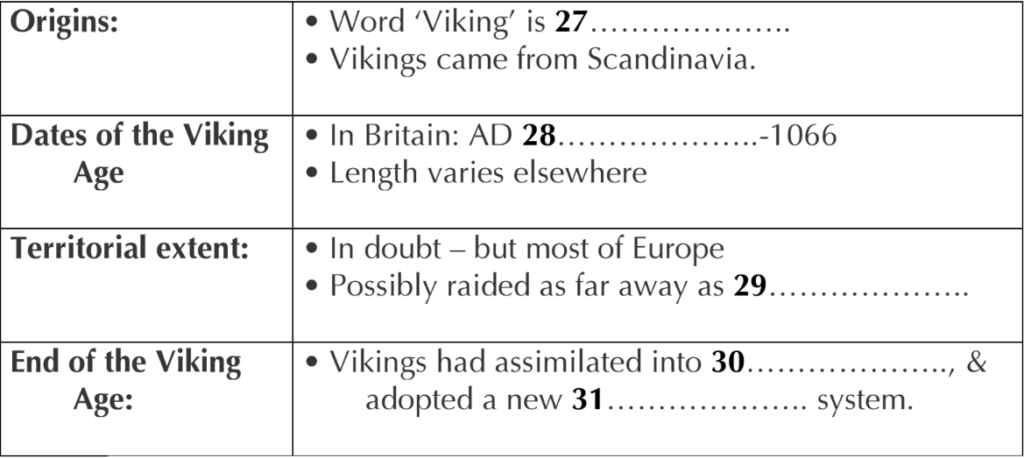
Questions 32 – 39:
32/ A geographer documents Viking culture as it happens.
33/ A philosopher classifies cultures hierarchically.
34/ Historians assert that Viking history is based more on legends than
facts.
35/ Young people learn about Viking cultural and economic activities.
36/ People see themselves as unrelated to Vikings.
37/ An historian claims Viking colonists to modem-day Canada came from his land.
38/ Viking conquests are exaggerated to bolster the country’s ego after a
territorial loss.
39/ DNA tests show locals are closely related to Swedes.
List of times & places
A In the UK today
B In 19th-century Norway
C In 19th-century Sweden
D In 19th-century England
E In Denmark today
F In 9th-century Persia
G In mid-20th century Soviet Union
H In Russia today
Questions 40:
Which might be a suitable title for passage 3?
A A brief history of Vikings
B Recent Viking discoveries
C A modem fascination with Vikings
D Interpretations of Viking history
E Viking history and nationalism
